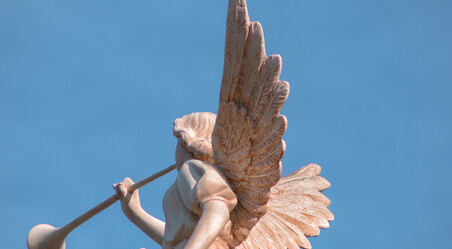The Catholic School: a sign of contradiction
Ferdi McDermott FAITH Magazine September - October 2007
The Second Vatican Council (in the Constitution Gravissmum Educationis, 28th October, 1965) taught that Catholic education should be characterised by four key elements. They make a good checklist for parents searching for the right school for their children: 1. Promotion of academic excellence; 2. Breadth (an all-round education); 3. Moral formation (teaching children to choose what it is right); 4. A formation in prayer, especially how to pray with the liturgy of the Church.
The Council Fathers are clear that every one of the four aspects is geared towards evangelisation: Catholic education should make a difference not just to the children at Catholic schools, but also to the world of work they will enter when they leave full-time education.
Catholic schools today are like a shop window for the Church: they should show Catholic life and witness at its most authentic, preparing the young to bear witness to the faith and to become the movers and shakers in every sphere of modern life. A good Catholic school, then, prepares its students “for service in the spread of the Kingdom of God, so that by leading an exemplary apostolic life they become, as it were, a saving leaven in the human community.” (GE. 25.)
In most modern schools, even in Catholic schools, attention is concentrated on the first of those four aspects, to the detriment of the other three. Good GCSE results ought to be part of a good Catholic education, but they are not the be-all and end-all.
Five years ago, with a group of Catholic friends, I started a Catholic school that self-consciously took Gravissimum Educationis as its blueprint. Before we started planning this great adventure, I sought the advice of an old hand in the field of Catholic boys’ schools, Eric Hester, well known to readers of this journal. Eric and I had been working together for a few years on MENTOR, a Catholic education magazine that lasted for seven years and did some important raising of awareness in our Catholic schools. I like Eric a lot and was delighted that he accepted my invitations to join a group of advisors for the school project.
I still remember the moment - after months of prayer, discussions and reflection - that it became obvious to Eric that I hadn’t been joking. He called me to say that if he was going to be in charge of this advisory group, then he had a piece of very important advice to give me that he hoped I would think about very seriously: “Forget all about it, Ferdi. It is too ambitious and will only end in tears. Think about this advice. It might be the best I ever give you.”
After a few moments silence, he then said that if I decided to ignore his first piece of important advice (something he rather expected!), he would still be delighted to help with the project, and to carry out the advisory role that I had asked of him.
Eric proved to be quite right. The project is too ambitious, and there have certainly been enough tears along the way. In the academic sphere, we have not always managed parents’ expectations perfectly, and because we are young plant, any falling short makes us vulnerable; but some batches of results, especially in English and in languages, have been better than most schools back home. In terms of Catholic formation and practice, there have been significant fruits. I remain convinced that our work has been - and continues to be - blessed by Almighty God, and that he permits the trials that come our way precisely for our own purification and sanctification.
Because of the cultural background of our first pupils and staff and the specific aims that the College sets for itself, it places its educational programme in the tradition of the pre-reformation public schools of England, such as Eton and Winchester. Schools such as these, as well as the colleges of Oxford and Cambridge, were founded on the basis of a community of Masters and students who lived, worked, ate and prayed together.
This is the model for Chavagnes: a Catholic life in common dedicated to teaching and learning, and to the praise of Almighty God. Based in a nineteenth century former junior seminary, with a beautiful neo-gothic chapel, the College is honoured to continue the ancient heritage of prayer and study that goes back to the medieval Benedictine priory that once stood on the site of the College. We all feel the holiness of the place and feel a genuine spiritual link with the priests and scholars who have lived and worked here before us.
There has also been a deliberate attempt to develop our particular situation into a strong culture for the College, mainly rooted in traditions that staff experienced in their own schools a generation ago, or in revivals of medieval traditions, such as that of the boy-bishop (a boy rules the College for a day on the feast of St Nicholas.)
This has proved a source of amusement for some secular journalists (particularly in the recent Channel Four documentary) who can’t see past the boy bishops, boars’ heads and Morris dancing, to see the seeds of faith that are flourishing and putting down deep roots in this rich cultural soil: an environment characterised we hope by an authentic quest of the Good, the True and the Beautiful.
In keeping with its medieval inspiration (and indeed with Gravissimum Educationis) Chavagnes places the liturgical life - which is at the heart of the Church - at the very heart of its own life as a College. The liturgy is itself a school for the soul and an inexhaustible source of grace, and this is why we make it available on a daily basis. Although at first it takes a little getting used to, pupils soon learn to appreciate the strong religious emphasis of the College, and find it a source of inspiration and support in their studies and in their personal development.
Isolated from our countrymen, like the Irish monks of the early Middle Ages, we have discovered that exile can be spiritually fruitful. It has probably made us rather eccentric, but also more ready turn to God in our difficulties and triumphs. (Sometimes, if one has fallen out with one’s colleagues over something, God is the only one left around who speaks English!)
Chavagnes is not, and was never meant to be, a model for other Catholic schools. Except perhaps in one respect: a Catholic school, like a Catholic family, should have a strong enough character, identity and sense of purpose to be a real sign of contradiction. Then, and only then, can it be a place of preparation for mission and a worthy shop window for the Church, providing a glimpse of the values of the kingdom of God, intensified and adorned with all the energy and enthusiasm of youth.





